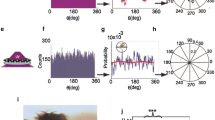Abstract.
The ability to detect and use the polarization of light for orientation is widespread among invertebrates. Among terrestrial insects, the retinula cells that are responsible for polarization detection contain a single visual pigment, either ultraviolet or short (blue) wavelength sensitive. With the exception of a few aquatic insects, the visual pigments underlying polarization sensitivity in aquatic invertebrates have yet to be determined. Here we report that polarotaxis in Daphnia pulex, a freshwater crustacean, is wavelength dependent and most likely mediated by two visual pigments with absorbance maxima in the middle (green) and long wavelength (red) parts of the spectrum. This contrasts with the response of a closely related species, D. magna, in which polarotaxis is wavelength independent and based on a single middle wavelength visual pigment. The visual systems in Daphnia are the first among crustaceans shown to utilize a middle wavelength pigment for polarization detection and, in the case of D. pulex, the first shown to use more than one visual pigment for such a purpose.
Similar content being viewed by others
Author information
Authors and Affiliations
Additional information
Electronic Publication
Rights and permissions
About this article
Cite this article
Novales Flamarique, I., Browman, H. Wavelength-dependent polarization orientation in Daphnia. J Comp Physiol A 186, 1073–1087 (2000). https://doi.org/10.1007/s003590000162
Accepted:
Issue Date:
DOI: https://doi.org/10.1007/s003590000162



